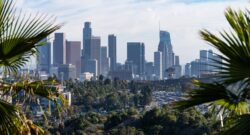Author: dailycastsocal
New Six- And Eight-Day Cruises From Long Beach To Cabo San Lucas, La Paz, Mazatlan, Puerto Vallarta, And Ensenada Now Available For Booking
Home » CRUISE NEWS » New Six- And Eight-Day Cruises From Long Beach To Cabo San Lucas, La Paz, Mazatlan, Puerto Vallarta, And Ensenada Now Available For Booking Sunday, July 27, 2025 Carnival Cruise Line has revealed exciting plans to extend its sailing calendar through 2027 and 2028, adding over 50 new voyages aboard the Carnival Panorama. These extended sailings will continue to depart from Long Beach, California, offering a convenient and reliable cruise option for travelers seeking to explore the beautiful Mexican Riviera. The newly available itineraries, which are already open for booking, will include both six- and eight-day cruises. These voyages focus on the stunning destinations along Mexico’s Pacific coast, offering guests the chance to experience some of the region’s most popular and scenic locations. For travelers seeking a shorter yet still immersive experience, the six-day cruises will feature extended stops in Cabo San Lucas, one of the top destinations in Mexico. Guests will have plenty of time to enjoy the area’s famous beaches, explore vibrant marine life through water activities, and take in the lively nightlife that Cabo has to offer. Additionally, these cruises will include a stop in Ensenada, a picturesque port town known for its stunning coastal landscapes and its position in Mexico’s wine region. Here, passengers can enjoy wine tasting tours, local culture, and breathtaking views of the Pacific coastline. For those craving a more in-depth exploration of the Mexican Riviera, the eight-day itineraries offer a more expansive experience. These cruises will visit multiple ports along the coast, including Cabo San Lucas, La Paz, Mazatlan, and Puerto Vallarta. Each of these cities offers unique experiences that highlight the rich culture, history, and natural beauty of the region. Mazatlan, known for its historic old town, invites travelers to wander through cobblestone streets lined with colonial architecture and explore the vibrant local art scene. La Paz, with its picturesque Malecon and serene beaches, provides a peaceful escape. Meanwhile, Puerto Vallarta captivates with its beautiful beaches, art districts, and a thriving culinary scene, offering guests the chance to enjoy some of the best dining and cultural experiences in Mexico. The Carnival Panorama has established itself as a beloved ship for West Coast cruisers, offering a consistent and dependable schedule for those wanting to explore the Mexican Riviera. The ship, which can accommodate over 5,000 passengers, boasts a range of onboard amenities that make it a perfect choice for families, groups, and solo travelers alike. One of the standout features of the Carnival Panorama is its wide array of entertainment and recreation options. The ship features the SkyRide, an aerial cycling course that provides breathtaking views of the ocean, as well as the Sky Zone trampoline park, where guests can enjoy fun, active play. For those looking to cool off, the WaterWorks water park offers slides and splash zones for the whole family. Additionally, the ship features a wide variety of dining venues, from casual eateries to fine dining, ensuring that every meal is a delightful experience. Entertainment options aboard the Carnival Panorama are equally diverse, with live shows, comedy acts, and themed events that cater to all interests. Whether you’re looking for a relaxed day at sea or an action-packed adventure, the Carnival Panorama offers it all, making it an ideal option for group travel and family vacations. As the extended sailings come into play, Carnival Cruise Line continues to strengthen its reputation as a leader in Mexican Riviera itineraries from the West Coast. These new cruises offer more choices for travelers looking to explore the stunning coastline of Mexico while enjoying the comfort and excitement of one of Carnival’s most popular ships. With round-trip departures from Southern California, these cruises provide the perfect opportunity for travelers to relax, unwind, and explore some of the most breathtaking destinations along the Pacific coast. The extended deployment of the Carnival Panorama ensures that more travelers will be able to enjoy the best of the Mexican Riviera, from its vibrant culture and historic cities to its stunning beaches and diverse recreational activities. With convenient departures from Long Beach and an exciting lineup of destinations, these new sailings are sure to attract cruisers looking for a fun and memorable vacation experience. Source link
More Insider’s Secrets When Visiting Los Angeles
Los Angeles is a sprawling metropolis known for its glitz and glamour, but peel back the layers, and you’ll find a wealth of hidden treasures waiting to be explored. Whether you’re a first-time visitor or a seasoned LA traveler, these insider tips will help you navigate the city like a local and uncover its best-kept secrets. 1. Embrace the Public Transport System While LA is notorious for its traffic, the city’s public transport system has been gaining traction. The Metro Rail offers a convenient way to reach many iconic destinations, from Hollywood to Santa Monica. Use the Metro app to plan your routes and discover stations near hidden gems like the Arts District or Little Tokyo. 2. Explore Diverse Neighborhoods Each neighborhood in Los Angeles has its own unique vibe. Don’t just stick to the tourist hotspots; take time to explore areas like: Silver Lake: Known for its indie music scene, eclectic shops, and vibrant murals. Echo Park: Home to charming cafes, paddle boats, and the iconic lake. Highland Park: A trendy area featuring vintage shops, artisan eateries, and a lively arts community. 3. Dine at Local Favorites Skip the standard chain restaurants and head to local favorites for authentic LA cuisine. Try: Guelaguetza: A celebrated Oaxacan restaurant known for its mole. Kogi BBQ: Famous for its Korean taco trucks where fusion food reigns supreme. Grand Central Market: A food hall with diverse offerings, from artisanal bread to fresh tacos – perfect for an afternoon snack. 4. Discover Hidden Parks and Gardens LA is home to stunning parks and gardens that provide a serene escape from the urban hustle. Some not-to-miss spots include: The Huntington Library, Art Museum, and Botanical Gardens: An expansive collection of rare books and breathtaking gardens. Griffith Park: Beyond the observatory, explore less-visited trails, picnic spots, and the Old Zoo ruins. Descanso Gardens: Renowned for its beautiful camellias and tranquil landscapes. 5. Utilize Local Resources Take advantage of local social media accounts and community boards for insider events and pop-up activities happening during your stay. Websites like Eventbrite or Meetup can also help you find unique experiences, such as food tours or local artist showcases. 6. Catch a Live Show From comedy clubs in West Hollywood to live music venues in downtown LA, there’s always something happening in the entertainment scene. Places like The Comedy Store or The Troubadour feature incredible talent and offer a glimpse into the local nightlife. Be sure to check schedules and book tickets in advance for a memorable evening. 7. Time Your Visits Wisely To avoid crowds, consider visiting popular attractions during off-peak hours. Early mornings or weekdays are generally quieter. Additionally, try to plan your outings around free entry days at museums or special events, which can enrich your experience without straining your budget. 8. Seek Out Cultural Experiences Los Angeles is a cultural melting pot, offering countless experiences that showcase its diversity. Visit: The Getty Center: Art, architecture, and gardens with stunning views of the city, all for free. LA’s Museum of Contemporary Art (MOCA): Discover cutting-edge exhibitions from renowned artists. Cultural Festivals: Eat, dance, and enjoy performances at annual events celebrating various cultures throughout the year. 9. Explore Off the Beaten Path Attractions In addition to famous spots, don’t miss out on unique attractions such as: The Los Angeles County Museum of Art (LACMA): Home to the iconic Urban Light installation, this museum is essential for art enthusiasts. The Old Trapper’s Lodge: A hidden gem nestled in the mountains, allowing you to step back in time and enjoy nature. The Abandoned Zoo in Griffith Park: A quirky, story-filled place that offers a glimpse into the city’s past. 10. Stay Flexible Finally, keep your itinerary flexible. Los Angeles is full of surprise pop-ups, unexpected sightings, and spontaneous adventures. Being open to change can lead you to hidden gems you never knew existed. By following these insider tips, you’ll be better equipped to navigate Los Angeles and discover the city’s hidden treasures. With its dynamic neighborhoods, vibrant culture, and eclectic dining options, LA offers countless opportunities for exploration beyond the obvious attractions. Enjoy your visit, and remember to leave time for spontaneity – that’s often when the best memories are made!
With Trump threats, Los Angeles should halt 2028 Olympics preparations
This event should not proceed. It is essential for greater Los Angeles to stop all arrangements for hosting the 2028 Summer Olympics. We should hand over these Games to another global city that is better equipped to manage them. Not because we lack appreciation for the Olympics. We are a city rich in Olympic history, marked by the 1932 and 1984 Games. Under normal circumstances, our unparalleled global connections, entertainment resources, and athletic facilities would make us an ideal host for what LA 28 chair Casey Wasserman calls “the largest peacetime gathering in the history of the world.” However, times are no longer peaceful in Los Angeles. This occasion has become too perilous for California. Hosting the Olympic Games requires collaboration with a chaotic U.S. administration — and its rights-violating security apparatus — as it actively wages war against our city and state. “National Special Security Events,” like the Olympics, necessitate that host cities allow federal agencies to take charge during the Games. For the 2028 Olympics, an agreement that began last year puts the U.S. Secret Service in control of security, alongside the FBI and the Department of Homeland Security. All these agencies are under President Donald Trump, who has initiated a war against California involving the deployment of troops and covert federal police in our communities. California leaders have justly called for the cessation of immigration raids and the withdrawal of troops. Yet, those demands contradict the Olympics agreement, which grants these agencies the authority to increase security personnel in Los Angeles. ‘Enforcement partners’ Trump Transportation Secretary Sean Duffy has directly linked the current federal presence in L.A. to the upcoming 2028 Olympics. He recently stated that Mayor Karen Bass and Gov. Gavin Newsom, by supporting protesters rather than ICE agents, have compelled the feds to assert control over the city — and suggested they might do so again. “If this was a preview of their leadership ahead of next year’s World Cup games and the L.A. 2028 Olympics, we have bigger problems,” Duffy stated. While this may seem like typical Trump rhetoric, California officials are actually citing the need to ensure a secure Olympics as a reason to collaborate with the very federal agencies that are currently assaulting the state. LAPD Chief Jim McDonnell, in his enthusiasm to proceed with the Games, resembles the British prisoner-of-war Colonel Nicholson from the film “The Bridge on the River Kwai,” who takes pride in constructing a railroad bridge that benefits his captors. McDonnell often refers to ICE as “law enforcement partners,” despite their actions against the city he is committed to safeguarding. When pressed by the L.A. city council on why he continued to collaborate with ICE, McDonnell responded: “Without that partnership, we wouldn’t be able to go into the World Cup, the Olympics.” This vulnerability illustrates how Trump can manipulate the Olympics against California. Therefore, it is crucial that California removes the president’s leverage by pausing operations immediately, setting a clear deadline, and outlining demands: We will withdraw from these Olympics by Aug. 1 unless the Trump administration halts all immigration raids, withdraws all federal troops in L.A., releases all immigration detainees, endorses an independent prosecutor to investigate the raids, and reinstates all frozen federal funding for California. Anything less, and we’re out. Threat to democracy Sports officials around the world would be outraged. However, if we forgo the Games, we could redirect our attention to the needs of our city. Longtime L.A. city administrator Rick Cole posed a critical question: “If we can’t pave our streets, repair our sidewalks, trim our trees, house our homeless, light our bridges, and fix our firetrucks, how can we host an Olympics in just three years?” Unexpected expenditures from the Games could burden public budgets that are already facing deficits. Additionally, Trump, known for abandoning partners, could attempt to impose billions in federal security costs onto L.A. Trump is also undermining the Games’ potential benefits. The Olympics can be profitable if people from around the world attend. Yet, Trump’s travel ban — combined with his administration’s willingness to detain and incarcerate tourists — will deter attendance. Some nations may even opt for a boycott. The most significant threat posed by a Trump Olympics is to our democracy. Trump has indicated his intention to leverage the Games to self-promote and solidify his authoritarian regime. We can expect to see Trump lighting the torch while seated among fellow autocrats — Hungary’s Orban, India’s Modi, and possibly even Putin. Indeed, the 2028 Games may occur while Trump is campaigning for an unconstitutional third term as president. Tyrants historically have exploited the Olympics for such purposes. (Look up “Adolf Hitler” and “1936 Berlin Olympics.”) Why should Californians invest our valuable time and resources into a fascist spectacle for our oppressor? If the 2028 Olympics proceed, they will likely be wielded as a tool by Trump against us. Joe Mathews writes the Connecting California column for Zócalo Public Square. Source link
San Diego Comic-Con 2025 | AnewZ
San Diego Comic-Con kicked off on Thursday with a reduced number of high-profile celebrity panels. Nevertheless, fans showed up in elaborate costumes and enthusiastic spirits. Richard Cao, 38, hailing from San Diego, shared that he spent months preparing for the event, shedding 30 pounds to portray a bare-chested Inosuke Hashibira from the anime series ‘Demon Slayer: Kimetsu no Yaiba.’ “I lost around 30 pounds over the course of six months; that’s just the physical commitment I chose to make,” Cao stated. This year at the San Diego Convention Center, the usual A-list panels from Marvel and DC Studios in Hall H are absent. However, notable highlights include the debut of ‘Star Wars’ creator George Lucas at Comic-Con, along with panels for Disney’s ‘Tron: Ares,’ ‘Predator: Badlands,’ and a discussion featuring Ryan Gosling in ‘Project Hail Mary.’ The world premiere of the revival of ‘King of the Hill’ will also showcase co-creators Mike Judge and Greg Daniels. For the first time, Comic-Con will host a two-day music festival, Crunchyroll Anime FanFest, organized by the Sony-owned anime streaming service Crunchyroll. This festival will present anime music, including ‘The One Piece 25th Anniversary Symphony Voyage.’ Crunchyroll boasts over 13 million subscribers worldwide. Despite the increase in travel and accommodation expenses, fans express that the experience is invaluable. “It’s absolutely worth it,” stated Sophia Blanco, 39, from New York City, who spent “a couple of thousands” on her trip. “When you go on vacation, you’re spending money regardless. So, invest in what you love, no matter what it is,” she added. The event is set to take place from July 24 to 27. Reuters Reuters Reuters Source link
Toddler dies after mother accidentally hits her with car in Long Beach – ABC7 Los Angeles
Toddler dies after mother accidentally hits her with car in Long Beach ABC7 Los Angeles Source link
California's 'heaviest' wave pool is generating local controversy – MSN
California’s ‘heaviest’ wave pool is generating local controversy MSN Source link
Dance of Dolphins Pod at SeaWorld San Diego #shorts #animals #trending #viralvideo #travel
india #california #sandiego #usa #korea #japan #dubai #orlando #seaworld #malaysia #thailand #vietnam #mexico #canada … source
What California still doesn’t understand about men’s mental health
Each year, a handful of headlines bring attention to Mental Health Awareness Month. Shortly thereafter, we tend to move on. However, the reality persists. For those whose lives have been touched by it, the sorrow endures. As a 26-year-old Black man and project director of a youth-led mental health initiative in Santa Cruz and Monterey counties, I’ve engaged in this work for years. My journey began at 12, the year I lost a sibling to suicide. At that time, I lacked the vocabulary — only the silence that ensued. This silence continues to haunt us. In California, young people aged 10 to 24 represent merely 21% of the population but account for 57% of all emergency room visits related to self-harm. This statistic should give us pause. For young men in this demographic — particularly Black and brown men — the pressures intensify. We face over-policing and under-protection, are urged to be resilient yet feel unsafe, and are expected to bear pain without the means to express it or without rest. Frequently, discussions around men’s mental health get co-opted, either to rationalize violence or to negate vulnerability. Algorithms often favor anger. Headlines diminish the complexity of the narrative. Influencers promote a version of masculinity based on dominance rather than clarity. What is labeled masculinity in America often masks unprocessed grief, styled in a fitted cap. Through my work with young individuals throughout California, I’ve witnessed the changes that occur when we create genuine space for feelings. I’ve seen boys begin to exhale when they understand that emotions are not weaknesses but rather signals. They’re indicators, a roadmap back to their true selves. However, healing demands more than trending hashtags. It requires safety, practical tools, and cultural permission to take a pause. What we need in California is the introduction of emotional literacy in schools, instead of merely trauma responses post-incident. We need culturally relevant healing environments that aren’t mediated by law enforcement. We need prevention initiatives grounded in a sense of belonging, rather than solely on diagnoses. We require a statewide narrative that regards emotional safety as a fundamental component of our infrastructure. This is fundamentally about design. We don’t need yet another awareness month. We need a future where emotional safety is a right — rather than a privilege. A future where no boy feels the need to conceal his grief because he was never taught how to articulate it. Men are not broken. We’re simply overdue for a redefined strength. Ayo Banjo is the founder of Banjo Strategies Consulting Group and serves as project director for The Village Project. This column was written for CalMatters. Originally Published: July 23, 2025 at 3:45 AM PDT Source link






